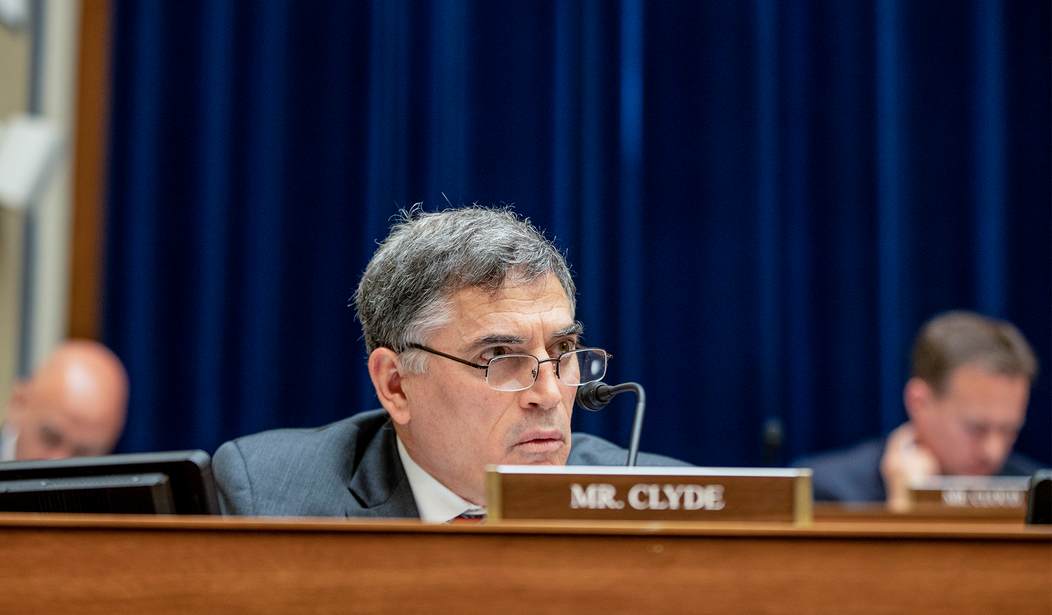The Biden administration’s new rules treating pistols equipped with stabilizing braces as short-barreled rifles subject to the provisions of the National Firearms Act is already in legal jeopardy, with federal lawsuits challenging the ATF’s authority to reclassify the items underway ahead of the May deadline for gun owners who own the items to register them with the agency.
Republicans in Congress are taking aim at the new rules as well; both through a Congressional Review Act resolution and legislation to formally undo the rule introduced in both chambers. With the Senate in control of Democrats, any legislation targeting the ATF’s new rule isn’t likely to be called up for a vote by Chuck Schumer, but Rep. Andrew Clyde says House Republicans will do everything they can to halt the rule’s enforcement; up to and including stripping the ATF of the funds needed to enforce the measure.
Rep. Andrew Clyde is pushing a resolution checking the administration, introduced almost a week ago, and already has 182 Republican cosponsors. He told The Washington Times that federal agencies are engaged in a power grab.
“The ATF has overstepped its bounds significantly. They’re not a legislative arm of the government,” the Georgia Republican said.
“They’re an executive arm. And when they legislate, which is what they’re doing, redefining a definition, then they have exceeded their authority.”
Mr. Clyde’s resolution is expected to pass easily in the House, but similar legislation from Republican Sens. John Kennedy of Louisiana and Roger Marshall of Kansas is expected to hit a wall in the Democrat-controlled Senate.
Mr. Clyde said Republicans will find a way to “take it down” anyway.
“We’ll defund the rule in appropriations. There’s multiple ways of taking this unconstitutional rule down, and we’re going to use every solitary one of them, because it’s wrong. Imagine not knowing about it. And in 120 days, becoming a felon.”
Clyde’s remarks are welcome news for Second Amendment activists, though some are calling for Republicans to go even bigger.
Citizens Committee for the Right to Keep and Bear Arms released a statement Monday.
“Clearly,” CCKRB Chairman Alan Gottlieb said, “Biden and the Democrats have decided that American gun owners are their enemy. They are scrambling to restrict the Second Amendment rights of tens of millions of citizens whose only offense is that they want to exercise their right to keep and bear arms. Last week, the president signed an executive order to create even more restrictions. Where does this stop?”
“The only way to derail this obsession,” he stated, “is for House and Senate Republicans to send a message to the White House and Capitol Hill Democrats by refusing to fund the agency Biden wants to unleash on law-abiding Americans. This war on the Second Amendment must stop now.”
If you need more evidence that Biden is trying to turn the ATF into a federally-funded gun control group with law enforcement powers, look no further than the ATF’s own “public safety advisory” issued on Tuesday regarding the agency’s rules on unfinished frames and receivers.
ATF issues public safety advisory to firearm industry. Advisory clarifies deliberate efforts to violate federal laws regulating the manufacture & sale of firearm frames and receivers will be investigated. https://t.co/phE7irIrA7 pic.twitter.com/WJlFFlZyB6
— ATF Los Angeles (@LosAngelesATF) March 21, 2023
A federal judge in Texas has already granted an injunction forbidding the new rules from being enforced against several companies and their customers, yet here’s the ATF trying to expand the rules to cover companies that “structure” sales of 80% frames and receivers along with the necessary tools to build your own gun.
Some suppliers of partially complete frames or receivers appear to be attempting to willfully circumvent the rule by (1) selling parts from the type of firearms parts kit covered by the final rule in separate transactions or (2) coordinating with other distributors to sell, market or make available individual parts that, when put together, create a frame or receiver.
When considering whether an individual or entity selling partially complete frames or receivers is engaged in activities that require a federal firearms license, ATF will consider the seller’s marketing conduct and materials. This may include the seller providing information on how a partially complete frame or receiver may readily be converted to a firearm, serving essentially as instructions or a guide. It may also include internet links to templates, jigs, molds, equipment, tools or other materials that enable ready completion or assembly of the unfinished frame or receiver into a firearm. This is because such materials may affect how “readily” the part may be converted. When a supplier in such a circumstance fails to comply with the GCA’s requirements, that may constitute a willful violation of the GCA. ATF considers such conduct, and all willful violations of the GCA, an investigative priority.
In his order granting an injunction to Polymer80 and its customers, U.S District Judge Reed O’Connor pointed out that no matter how vociferously government attorneys argue otherwise, the ATF “has no general authority to regulate weapon parts.” The agency can regulate completed firearms, or finished frames and receivers, but “the Final Rule regulates weapon parts kits that are ‘designed to or may readily be completed, assembled, restored, or otherwise converted to expel a projectile by the action of an explosive.'”
The statute covers “any weapon” that is “designed to” or “may readily be converted to” fire a projectile. 18 U.S.C. § 921(a)(3)(A) (emphasis added). Congress’s definition does not cover weapon parts, or aggregations of weapon parts, regardless of whether the parts may be readily assembled into something that may fire a projectile.
…
In sum, the Gun Control Act’s precise wording demands precise application. Congress could have described a firearm as “any combination of parts” that would produce a weapon that could fire a projectile. It used that language elsewhere in the definition. Congress could have described a firearm as any part “designed” to be part of a weapon. It used that language too. Congress could have described a firearm as a set of parts that “may be readily assembled” into a weapon, as it did for “destructive device.” Congress knew the words that would accomplish those ends. But Congress did not regulate firearm parts as such, let alone parts kits that are “designed to or may readily be completed, assembled, restored, or otherwise converted to expel a projectile by the action of an explosive.”
The ATF has repeatedly abused its regulatory powers and has been smacked around by the courts for doing so; both in the frames and receiver rule and the Fifth Circuit Court of Appeals’ recent decision overturning the ATF’s ban on bump stocks. Hopefully the courts will step in and deliver another defeat to the Biden administration’s pistol brace rule, but if an injunction isn’t granted by the time the deadline is reached in May the GOP’s threat to strip the ATF of the funding necessary to enforce the law will need to be backed up with action.









